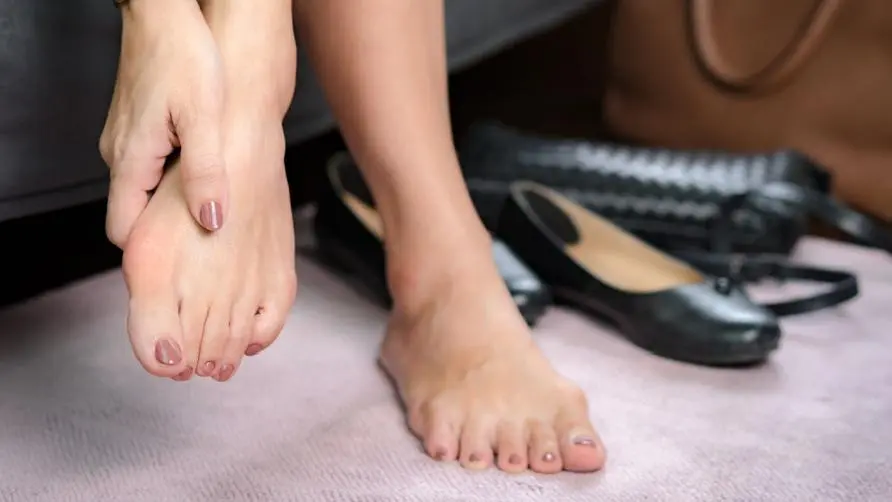Wearing high heels is not the only cause of thumb valgus? Doctors remind 6 major risk groups: If the valgus exceeds XX degree, surgery may be required

Move your whole body with just one “finger”! Who are at risk for hallux valgus?
Foot health not only affects the quality of life, but may also involve pain in various parts of the body and normal walking ability. Among foot diseases, “hallux valgus” is one of the most common forefoot deformities. Hallux valgus refers to the metatarsal joint of the big toe tilting inward toward the second toe. In severe cases, the second toe may overlap on top of the big toe. However, most people with hallux valgus tend to ignore it before it affects their walking. Deformation problem. In addition to causing pain and swelling in the big toe, hallux valgus will also aggravate inflammation and swelling if the toe rubs against shoes for a long time, making it difficult to walk and even causing knee pain, shoulder pain, low back pain and other conditions.
Dr. Lin Zongyu, the attending physician of the Department of Sports Medicine and Orthopedics at Mackay Memorial Hospital, said in an interview with “healthorn” that about 70% of hallux valgus comes from familial inheritance, and the age of occurrence mostly falls between 30 and 50 years old. Women are affected by hormones and have a higher incidence rate. It is 15 times higher in men. In addition, women are more likely to wear shoes with narrow lasts or high heels, which will also increase the incidence of hallux valgus. It seems that genetic genes have determined the incidence of hallux valgus. However, for feet with abnormal arches such as flat feet and high-arched feet, the lack of support in the inner arch can easily lead to the big toe being less able to support body weight and increasing the risk of hallux valgus. , a history of some autoimmune diseases such as rheumatoid arthritis is also a risk factor for hallux valgus.
Dr. Lin Zongyu pointed out that hallux valgus is affected by prenatal and acquired factors, causing many women to suffer. In addition to knowing whether they have a family history, they can also detect foot pressure early and choose suitable shoes and insoles according to the foot type to reduce the risk of foot pressure. Excessive pressure on the toe and excessive friction on the toe and metatarsal joints. It is more important to seek medical examination as soon as possible when foot pain occurs, in order to prevent bunion valgus from worsening or even requiring surgery.
What is the clinical definition of hallux valgus? Should surgery be performed if the valgus angle exceeds 40 degrees?
How to clinically diagnose hallux valgus? Dr. Lin Zongyu explained that the most important tool for checking hallux valgus is X-ray. Generally speaking, when the hallux valgus angle (HVA) exceeds 15 degrees and the intermetatarsal angle (IMA) exceeds 10 degrees, it is defined as a hallux valgus. When the hallux valgus angle exceeds 40 degrees and the inter-metatarsal angle exceeds 18 degrees, it is classified as “severe” hallux valgus. Severe hallux valgus will cause repeated inflammation and excessive compression of the second toe, resulting in obvious Deformation.
Once it progresses to severe hallux valgus, most cases cannot be improved through correction, and surgery must be performed to correct the foot deformity.
How to prevent thumb valgus from affecting foot health? “Toe guessing” helps relieve redness, swelling and pain
If you have mild hallux valgus or plantar pain, you can reduce the uncomfortable symptoms through appropriate stretching exercises and protective measures. Dr. Lin Zongyu recommends soaking your feet in warm water for 15-20 minutes on weekdays to enhance blood circulation and relieve tight muscles. You can also practice “rock-paper-scissors” on the soles of your feet to stretch your joints and relax your soles. When there is redness, swelling and pain in the foot, it is recommended to apply ice to relieve the swelling in the acute stage. Wearing toe protectors in a timely manner can also help reduce toe pain.
Dr. Lin Zongyu reminds that for people who are at risk of hallux valgus, wearing appropriate shoes is very important to protect the soles of the feet. In particular, many women are influenced by popular culture and prefer to wear various non-protective slippers or pointed shoes that easily increase pressure on the feet and metatarsal joints, which may aggravate the symptoms of hallux valgus. If it cannot be avoided, it is recommended to wear it for short periods of time and short distances.
The pressure distribution on the sole of the foot and the width of the last will affect the health of the sole of the foot. Dr. Lin Zongyu recommends that if you have sole or big toe problems and need to adjust your shoes, you can go to a medical institution or a store that provides professional foot pressure measurement. Foot pressure detection can help you understand your gait habits, foot pressure distribution, center of gravity and other important indicators of your feet, and then adjust suitable shoes or insole assistive devices, which can help improve foot health and prevent big toe extrusion and Deformation.
Extended reading: Trendy coffee becomes a popular coffee! Can wearing Jordans cause plantar fasciitis? Harvard: The more you know how to “warp”, the bigger the problem will be





